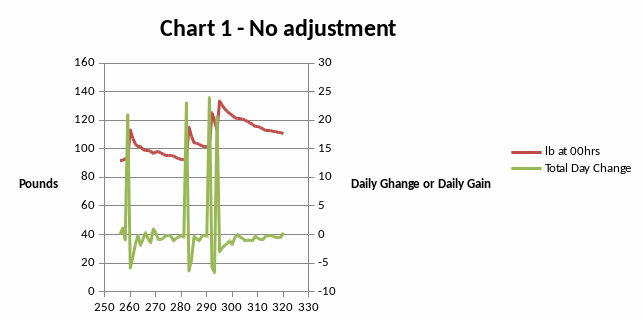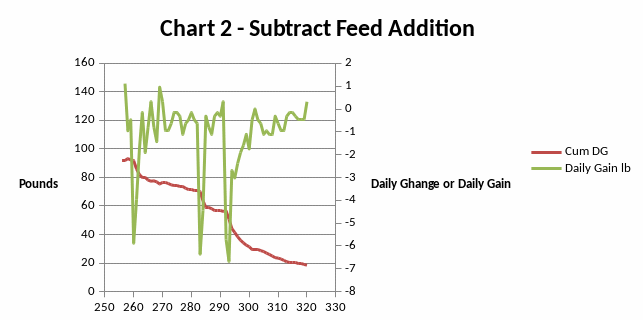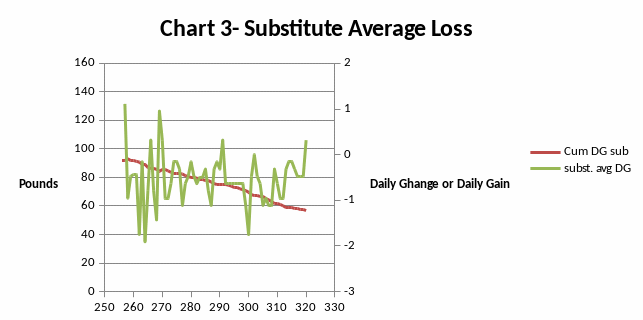Feeding Scale Hives
Feeding Methods
[Editor's note: Dr. Wayne Esaias, Honey Bee Net, discusses adjusting scale hive records to eliminate distortions due to feeding and gives an extreme example showing this approach for trying to adjust for feeding artifacts. The term "daily gain" is used to represent both positive gains, and negative gains (which are weight losses).]
Colonies must be fed on occasion and the scale record will show several effects. My objective is to account for the beekeeper induced changes so that the record reflects the interaction of the colony and the environment.
Alternative Method: An option for serious scalers is to just add a frame of ripe honey all at once as a management manipulation. The hivetool program will identify that with no problem and there is no need to worry about subsequent evaporation anomaly, because there will be none.
Bulk Feeders: For open, community feeding, where syrup is available in open vessels to the whole apiary, about the only thing that can be done is to flag the entire period as an anomalous gain, and substitute either zero daily gain or an average daily gain (loss) for the colony either before or after syrup is provided. Its impossible rule out gains due to collection of wild nectar, during the interval, but generally feeding is done during dearths anyway. The gains seen by scales hives during open feeding episodes are certainly real, but do not reflect gains due to natural forage. The same applies to the situation where bees are allowed to rob out wet supers and extracting gear in the open. Those days are just lost to the scale hive record. Please make a note of this if you do it, when it begins, and when it is over because otherwise it looks like a minor nectar flow. For polishing up wet supers, it is much better to add them to individual hives as management changes. A before and after measurement will give you an idea of how much honey they cleaned out, and it deters starting robbing in the apiary. There is no need for correction for excess water as discussed below.
Hive Feeders: In-hive feeding includes Miller type hive top feeders, inverted jars, frame feeders, entrance feeders, chicken water feeders under protective boxes and the like, where one can assume only the hive in question receives its benefit. It is important to note the weight (or volume) of the syrup and its concentration, in addition to the weight of accessory fixtures such as the hive top feeder, box to shade a jar, etc. when they are first installed. For manual operations, the weight addition needs to be recorded at the time it is put on the colony. For electronic loggers, the weight change is readily obtained from the record itself. When syrup is replenished after the bees have emptied the container, by refilling, only the weight (volume) and concentration of the syrup is needed since the protective box or Miller type feeder is already on the scale.
Adjustment of scale hive records
Example: This spreadsheet is from a hive with a hive top feeder at the Beltsville Bee Research Lab in the fall of 2011 during the dearth period. 250 lb of granulated sugar is added to a 55-gallon drum half full of hot water, and then filled with hot water with stirring. This concentration is very nearly 1:1, or 50% by weight, so we will assume it is. Syrup is pumped thru a hose to hive top feeders. The scale is a Fairbanks beam balance scale equipped with a load cell and NASA data logger, digitized with a resolution of 0.15 lb and estimated accuracy of 0.3 lb. Weight is also manually recorded every workday at about 7:30 am.
The sheet ‘full plot’ shows temperature and logged volts (proportional to lbs) and 4 feeding events, each greater than 20 lb as shown in the attached workbook.
Chart 1 shows the weight recorded at 00 hrs. (Midnight) and the daily change from midnight to 23:59:59 hrs. (essentially midnight of the next day) plotted vs. day of year. The weight of the hive increases over time due to added syrup and decreases in-between. There is an immediate rapid increase followed by a rapid decrease over the following several days, which is followed by a more gradual, steady decrease until the next feeding. The daily change record is dominated by the addition of syrup.
Chart 2 shows the same parameters but with the incremental (10 minute) change due to syrup addition subtracted from the end of day weight. The daily change is now dominated by large losses immediately after the addition, and the adjusted cumulative weight decreases over time with steep declines immediately after feeding. The large weight losses (up to 6.8 pounds/day) are due to evaporation of excess water from the 1:1 syrup, and do not reflect natural colony-environment interaction.
To account for the rapid evaporative losses, we substituted an average loss rate for those days that were impacted. The loss rate was estimated from portions of the record with steady slow declining weight consistent with the overall dearth. Substituted values are shaded yellow in the spreadsheet, and pink shading denotes computation of the average value used.
Chart 3 shows that the adjusted weight is now more or less a continuous decline at an average daily change of - 0.59 lb/day. The daily gain is no longer dominated by feeding induced artifacts, and more closely approximates the natural interaction of the colony with the surrounding environment.
Since we know that the syrup was very close to 50% sucrose by weight, we can estimate how much water was in excess over ripened stores at 82% sugar by weight. This algebraic calculation comes to about 40% of the total initial syrup weight. The rapid weight loss by the colony in days immediately following feeding (the actual weight loss minus the substituted average) is very close to the excess weight of water added (compare green shaded cells in columns I and K; note that the last 2 feeding events overlapped and the total excess is 18.8 lb). This is reassuring, and can serve as a guide to how many days are required for weight losses to resume their natural value. We note that the evaporation period is short (2 days) in the beginning of the record when it is still fairly warm, and longer (~5 d) in October/November when temperatures are lower, and bee activity is lower.
An additional observation is that the rapid loss following feeding is more or less continuous (day and night) in September and early October for the first two feedings and the electronic 10 minute weight loss looks very smooth over several days. However, in late October, the electronic weight record shows that the rapid loss occurs only during the daytime. Nights are cooler and the bees are only active during the warmer portions of the day. Night-time loss rates in late October and November are very close to the overall loss rate seen at the very end of the record for both day and night. This is consistent with the concept that the natural nighttime loss rate reflects the overall metabolism of the colony plus evaporative losses (if any) during nectar flows.
Caveats and assumptions: Impact of any robbing (either robber or victim), rain and its evaporation, and gains or losses due to humidity changes are unknown but may be present. The scale is sheltered with a roof, but is in a yard where fall feeding can stimulate robbing. Second, use of a hive top feeder during the dearth induces what is close to a robbing feeding frenzy inside the hive that goes on at night (personal experience), which likely increases the metabolic losses produced by the agitated colony compared to the quiescent periods. We have not attempted to estimate any increased loss rate due to this, but it would necessitate use of a larger loss rate than I have used. Finally, this is a probably an extreme example of feeding effects, I think. Not everyone uses 1:1 in hive top feeders with 24 lb doses, but it does serve to illustrate some feeding impacts to scale records fairly well.
Leaky Feeders: A question was raised about how to treat a record in which a leaky entrance feeder was used to feed a quart at a time, and sunlight caused the feeder to leak profusely. Answer: Use an average daily loss rate as a substitute. The amount of syrup leaked cannot be quantified. With only a quart the overall effects is likely to be small compared to other error sources, but may still be apparent in a good electronic scale record. A quart of 1:1 is about 2.5 lb of syrup, and so one would expect an anomalous loss of about 1 lb from evaporation following its application. It is impossible to distinguish the loss due to a leaky feeder from robbing, or from other loss factors, without additional information. In fact using small reservoirs frequently may make any estimate of a natural loss rate very difficult to extract. So, stay away from entrance feeders that are not protected against leaking when heated during the day. Even inverted gallon jars with only a few small holes in the lid may still require close watching for leaks. An average loss rate must be assumed for the duration, so it might be better to use a larger volume than a quart in order to add stores quickly, to get the impact over with and preserve the rest of the record in an unperturbed state.
There is also a management take-away regarding use of hive top feeders for stimulative feeding in the spring. 1:1 syrup can be used to add stores in the fall, as we have seen, but is typically used in the spring and early fall to simulate a nectar flow and to stimulate brood rearing in the colony. Concentration of 50% resembles natural nectar. Not many beekeepers use two gallons at a crack in hive top feeders. I was surprised to see over 2 gallons ‘used, or taken down, or completely ripened’ in two days as happened repeatedly in this example, and in 2010, and as I have seen in my own apiary using 2:1. Using inverted gallon jars with only a few small holes to feed 1:1 gives a more extended simulation period (4-6 days) in the spring.
During a natural nectar flow the hive is in more or less a steady state situation with respect to nectar coming in and evaporation to convert it to honey. If this goes on for several days at a more or less constant rate, then the daily increase is a good measure of honey production, not nectar collected. Its all part of the interaction with the environment, and no ‘adjustments’ for evaporative losses are in order.
This treatment requires several assumptions as discussed above, and is meant to provide a more meaningful scale hive representation of the interaction of the colony with the environment. I would appreciate any comments.


